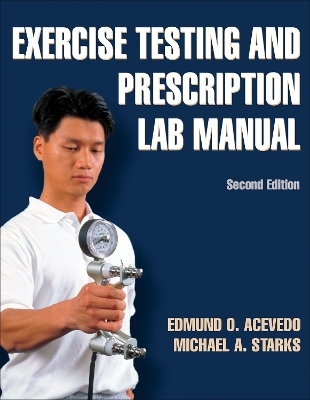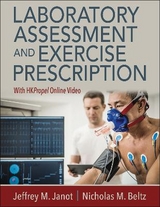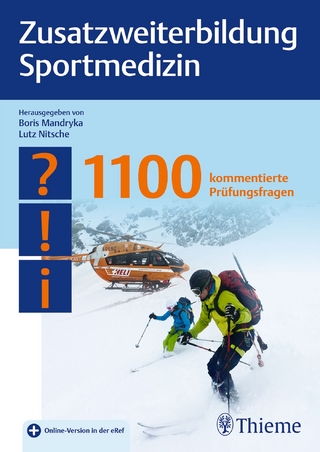
Exercise Testing and Prescription Lab Manual
Human Kinetics (Verlag)
978-0-7360-8728-5 (ISBN)
- Titel erscheint in neuer Auflage
- Artikel merken
With a focus on foundational information, the Exercise Testing and Prescription Lab Manual, Second Edition, offers practical application of knowledge and skills associated with standardized health- and fitness-related tests. Progressing through 14 easy-to-follow experiential-based learning labs, readers will gain the skills and techniques required for successful completion of the ACSM Certified Health Fitness Specialist certification (CHFS).
The improved second edition includes the latest updates consistent with the recent modifications published within the ACSM’s Guidelines for Exercise Testing and Prescription, Eighth Edition. In this new edition, readers will also find the following features:
•In-depth content regarding functional parameters related to exercise, especially in regard to heart rate and blood pressure
•Additional information on body composition testing focusing on improved knowledge and skills related to assessment of skinfolds and circumferences
•New emphasis on the importance of assessment and how assessment relates to overall program development
•An updated format that flows progressively through testing and prescription
•Enhanced discussion questions within each lab, which incorporate more in-depth analysis of the information being covered
Though most closely matched with ACSM CHFS certification guidelines, Exercise Testing and Prescription Lab Manual, SecondEdition, is also useful for individuals preparing for certification within other training organizations or as a resource for the ACSM Certified Personal Trainer certification. The progression of labs through the testing and prescription process, easy-to-follow instructions, and forms and worksheets also make this lab manual an excellent experiential component for a course in exercise testing and prescription.
Exercise Testing and Prescription Lab Manual, Second Edition, is organized into three sections covering pretest responsibilities, exercise testing techniques, and exercise prescription. Readers will learn safety procedures and requirements for exercise testing equipment, follow step-by-step instructions for calibration of laboratory instruments, and learn guidelines for medical history evaluation, risk factor evaluation and stratification, and informed consent.
Next, the application of techniques used in assessing the components of health-related fitness is presented. Within the exercise prescription section, readers learn about the calculation of metabolic work, the three phases of exercise prescription, assessment of participants’ goals, and gaining participants’ commitment to the exercise prescription. A final comprehensive lab challenges readers to apply techniques and principles in developing various case studies.
Each lab features the same easy-to-follow format outlining the purpose of the lab, materials required, background information, procedures, discussion questions, and references. Detailed appendixes contain a summary of the effects of common pharmacological agents on cardiorespiratory responses at rest, common metric conversions used in exercise testing and prescription calculations, a list of metabolic and anthropometric formulas, and answers to lab questions. The appendixes also contain all forms and worksheets required for colllecting data and completing the lab assignments.
The second edition of the Exercise Testing and Prescription Lab Manual provides focused, step-by-step preparation for those studying for the ACSM CHFS certification. With its reorganized format, up-to-date information, and forms and worksheets, this text is also a valuable best-practices reference for health and fitness specialists certified by the ACSM and other organizations.
Edmund O. Acevedo, PhD, is a professor and chair of the department of health and human performance at Virginia Commonwealth University. He is a fellow of the American College of Sports Medicine and the American Psychological Association. He is an ACSM-certified clinical exercise specialist. His 21-year career in research and teaching has cemented his commitment to standardized fundamentals for exercise testing and prescription. Dr. Acevedo makes his home in Midlothian, Virginia, with his wife, Tracy, and their two children. In his free time, he enjoys on- and off-road running and biking. Michael A. Starks, PhD, is an adjunct professor in the college of education at the University of Memphis. He is a certified strength and conditioning specialist from the National Strength and Conditioning Association and is a CPR and first aid instructor for the National Safety Council and American Red Cross. Starks makes his home in Germantown, Tennessee, with his wife, Stacy, and three children. In his free time, he enjoys resistance training, competing in triathlons, and coaching.
Part I: Pretest Responsibilities
Lab 1: Orientation to Lab Instruments, Procedures, and Responsibilities
Lab 2: Calibrating Lab Instruments
Lab 3: Risk Factor Evaluation, Medical History, and Informed Consent
Part II: Techniques in Exercise Testing
Lab 4: Heart Rate and Blood Pressure Assessment Techniques
Lab 5: Skinfold and Circumference Assessment Techniques
Lab 6: Assessing Body Fatness
Lab 7: Submaximal Exercise Test Protocols
Lab 8: Evaluating Muscular Strength and Endurance
Lab 9: Evaluating Flexibility
Lab 10: ECG Placement and Monitor Operations
Part III: Exercise Prescription
Lab 11: Metabolic Calculations
Lab 12: Assessing Participant Goals and Gaining Commitment to Physical Activity
Lab 13: Prescriptions for Initial Conditioning, Improvement, and Maintenance
Lab 14: Case Study Reports
| Verlagsort | Champaign, IL |
|---|---|
| Sprache | englisch |
| Maße | 216 x 279 mm |
| Gewicht | 499 g |
| Themenwelt | Medizin / Pharmazie ► Medizinische Fachgebiete ► Sportmedizin |
| ISBN-10 | 0-7360-8728-1 / 0736087281 |
| ISBN-13 | 978-0-7360-8728-5 / 9780736087285 |
| Zustand | Neuware |
| Informationen gemäß Produktsicherheitsverordnung (GPSR) | |
| Haben Sie eine Frage zum Produkt? |
aus dem Bereich



